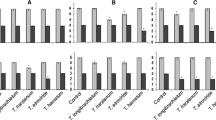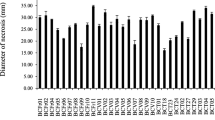Abstract
Endophytic strains of Trichoderma species can be used as an alternative to chemicals to control vascular streak dieback (VSD) disease of cacao. Of 21 Trichoderma isolated from Theobroma cacao (cacao) in Indonesia, 19 were identified as Trichoderma asperellum. Four isolates of this species (ART-4, ART-5, ART-6 and ART-8) were reintroduced into young cocoa seedlings by root inoculation and after 4 weeks all were recovered from roots and stems, while ART-4 and ART-5 were recovered from leaves as well. Spraying seedlings pre-inoculated with T. asperellum ART-4, ART-5 and ART-6 with mycelium of the VSD pathogen Ceratobasidium theobromae resulted in no apparent VSD symptoms on the leaves. Those seedlings pre-inoculated with ART-8 showed 8.9 % incidence of VSD symptoms on the leaves when compared to a 20.4 % incidence of VSD on positive control leaves, 12 weeks after inoculation. The same isolates were also reintroduced into 3-month-old cocoa seedlings via the connecting site following shoot grafting, and after 12 weeks all isolates were recovered from stem and leaves. Seedlings grafted with buds infected by VSD and treated by ART-4 showed no VSD symptoms on their leaves 12 weeks after grafting and inoculation. However, those treated with ART-5, ART-6 and ART-8 showed 33.3 %, 50.0 % and 56.0 % incidence of VSD symptoms on their leaves, respectively, compared to an 88.9 % incidence of VSD on positive control leaves. Therefore, the study results demonstrates for the first time the potential of T. asperellum isolates to control VSD disease on cacao.


Similar content being viewed by others
References
Anshary A (2002) Karakteristik tanaman kakao (Theobroma cacao L) yang resisten terhadap penggerek buah kakao Conopomorpha cramerella (Snellen) (Lepidoptera: Gracillariidae). Desertasi Program Pascasarjana. Universitas Hasanuddin, Makassar
Arnold AE, Mejia LC, Kyllo D, Rojas EI, Maynard Z, Robbins N, Herre EA (2003) Fungal endophytes limit pathogen damage in a tropical tree. Proc Natl Acad Sci U S A 100:15649–15654
Atanasova L, Le Crom S, Gruber S, Coulpier F, Seidl-Seiboth V, Kubicek CP, Druzhinina IS (2013) Comparative transcriptomics reveals different strategies of Trichoderma mycoparasitism. BMC Genomics 14:121
Bae H, Roberts DP, Lim H-S, Strem MD, Park S-C, Ryu C-M, Melnick RL, Bailey BA (2011) Endophytic Trichoderma isolates from tropical environments delay disease onset and induce resistance against Phytophthora capsici in hot pepper using multiple mechanisms. Mol Plant-Microbe Interact 24:336–351
Bailey BA, Bae H, Strem MD, Crozier J, Thomas SE, Samuels GJ, Vinyard BT, Holmes KA (2008) Antibiosis, mycoparasitism, and colonization success for endophytic Trichoderma isolates with biological control potential in Theobroma cacao. Biol Control 46:24–35
Bailey BA, Strem MD, Wood D (2009) Trichoderma species form endophytic associations within Theobroma cacao trichomes. Mycol Res 113:1365–1376
Carbone I, Kohn LM (1999) A method for designing primer sets for speciation studies in filamentous ascomycetes. Mycologia 91:553–556
Chang YC, Chang YC, Baker R, Kleifeld O, Chet I (1986) Increased growth of plants in the presence of the biological control agent Trichoderma harzianum. Plant Dis 70:145–148
Chaverri P, Gazis RO, Samuels GJ (2011) Trichoderma amazonicum, a new endophytic species on Hevea brasiliensis and H. guianensis from the Amazon basin. Mycologia 103:139–151
Dodd SL, Lieckfeldt E, Chaverri P, Overtom BE, Samuels GJ (2002) Taxonomy and phylogenetic relationship of two species of Hypocrea with Trichoderma anamorphs. Mycol Prog 1:409–428
Evans HC, Holmes KA, Thomas SE (2003) Endophytes and mycoparasites associated with an indigenous forest tree, Theobroma gileri, in Ecuador and a preliminary assessment of their potential as biocontrol agents of cocoa diseases. Mycol Prog 2:149–160
Guest D, Keane PJ (2007) Vascular streak dieback: a new encounter disease of cacao in Papua New Guinea and Southeast Asia caused by the obligate basidiomycete Oncobasidium theobromae. Phytopathology 97:1654–1657
Hanada RE, Jorge Souza TD, Pomella AW, Hebbar KP, Pereira JO, Ismaiel A, Samuels GJ (2008) Trichoderma martiale sp. nov., a new endophyte from sapwood of Theobroma cacao with a potential for biological control. Mycological Research 112:1335–1343
Harman GE, Howell CR, Viterbo A, Chet I, Lorito M (2004) Trichoderma species -opportunistic, avirulent plant symbionts. Nat Rev Microbiol 2:43–56
Hermosa R, Viterbo A, Chet I, Monte E (2012) Plant-beneficial effects of Trichoderma and of its genes. Microbiology 158:17–25
Hermosa R, Rubio MB, Cardoza RE, Nicolas C, Monte E, Gutierrez S (2013) The contribution of Trichoderma to balancing the costs of plant growth and defense. Int Microbiol 16:69–80
Holmes KA, Schroers HJ, Thomas SE, Evans HC, Samuels GJ (2004) Taxonomy and biocontrol potential of a new species of Trichoderma from the Amazon basin in South America. Mycol Prog 3:199–210
Krauss U, Hidalgo E, Bateman R, Adonijah V, Arroyo C, García J, Crozier J, Brown NA, Hoopen GM, Holmes KA (2010) Improving the formulation and timing of application of endophytic biocontrol and chemical agents against frosty pod rot (Moniliophthora roreri) in cocoa (Theobroma cacao). Biol Control 54:230–240
Kubicek CP, Bisset J, Druzhinina I, Kullnig-Gradinger C, Szakacs G (2003) Genetic and metabolic diversity of Trichoderma: a case study on South-East Asian isolates. Fungal Genet Biol 38:310–319
Rifin A (2013) Competitiveness of Indonesia’s cocoa beans export in the world market. International Journal of Trade, Economics and Finance 4:279–281
Ruf F (2007) The cocoa sector: Expansion, or green and double green revolutions. Background note presented on ODI/International Food Policy Research Institute Workshop. Accra, Ghana. IFPRI
Samuels GJ, Ismaiel A (2009) Trichoderma evansii and T. lieckfeldtiae two new T. hamatum-like species. Mycologia 101:142–156
Samuels GJ, Pardo-Schultheiss RA, Hebbar KP, Lumsden RD, Bastos CN, Costa JC, Bezerra JL (2000) Trichoderma stromaticum sp. nov., a parasite of the cacao witches broom pathogen. Mycol Res 104:760–764
Samuels GJ, Dodd SL, Gams W, Castlebury LA, Petrini O (2002) Trichoderma species associated with the green mold epidemic of commercially grown Agaricus bisporus. Mycologia 94:146–170
Samuels GJ, Dodd SL, Lu B-S, Petrini O, Schroers H-J, Druzhinina IS (2006a) The Trichoderma koningii aggregate species. Stud Mycol 56:67–133
Samuels GJ, Suarez C, Solis K, Holmes KA, Thomas SE, Ismaiel A, Evans HC (2006b) Trichoderma theobromicola and T. paucisporum: two new species from South America. Mycol Res 110:381–392
Samuels GJ, Ismaiel A, Rosmana A, Junaid M, Guest D, McMahon P, Keane P, Purwantara A, Lambert S, Rodriguez-Carres M, Cubeta MA (2012) Vascular Streak Dieback of cacao in Southeast Asia and Melanesia: in planta detection of the pathogen and a new taxonomy. Fungal Biol 116:11–23
Shapiro LH, Scheffer SJ, Maisin N, Lambert S, Purung HB,Sulistyowati E, Vega FE, Gende P, Laup S, Rosmana A, Djam S, Hebbar PK (2008) Conopomorpha cramerella (Lepidoptera: Gracillariidae) in the Malay Archipelago: genetic signature of a bottlenecked population? Annals of the Entomological Society of America 10: 930–938
Shoresh M, Harman GE, Mastouri F (2010) Induced systemic resistance and plant responses to fungal biocontrol agents. Ann Rev Phytopathol 48:21–43
Sriwati R, Chamzurni T, Sukarman (2011) Deteksi dan identifikasi cendawan endofit Trichoderma yang berasosiasi pada tanaman kakao. Jurnal Agrista 15:15–20
Acknowledgments
The authors are grateful to the Indonesian Agency for Agricultural Research and Development, Ministry of Agriculture and Directorate General of Higher Education, Ministry of Education and Culture who have supported this research through KKP3T and PAR-C research grants, respectively. Also, we would like to thank the University of Maryland and the United States Department of Agriculture, Beltsville, MD, USA, for giving permission to complete the research in their laboratories.
Author information
Authors and Affiliations
Corresponding author
Additional information
Section Editor: Wagner Bettiol
Rights and permissions
About this article
Cite this article
Rosmana, A., Samuels, G.J., Ismaiel, A. et al. Trichoderma asperellum: A Dominant Endophyte Species in Cacao Grown in Sulawesi with Potential for Controlling Vascular Streak Dieback Disease. Trop. plant pathol. 40, 19–25 (2015). https://doi.org/10.1007/s40858-015-0004-1
Received:
Accepted:
Published:
Issue Date:
DOI: https://doi.org/10.1007/s40858-015-0004-1




